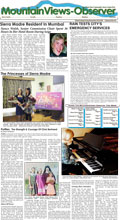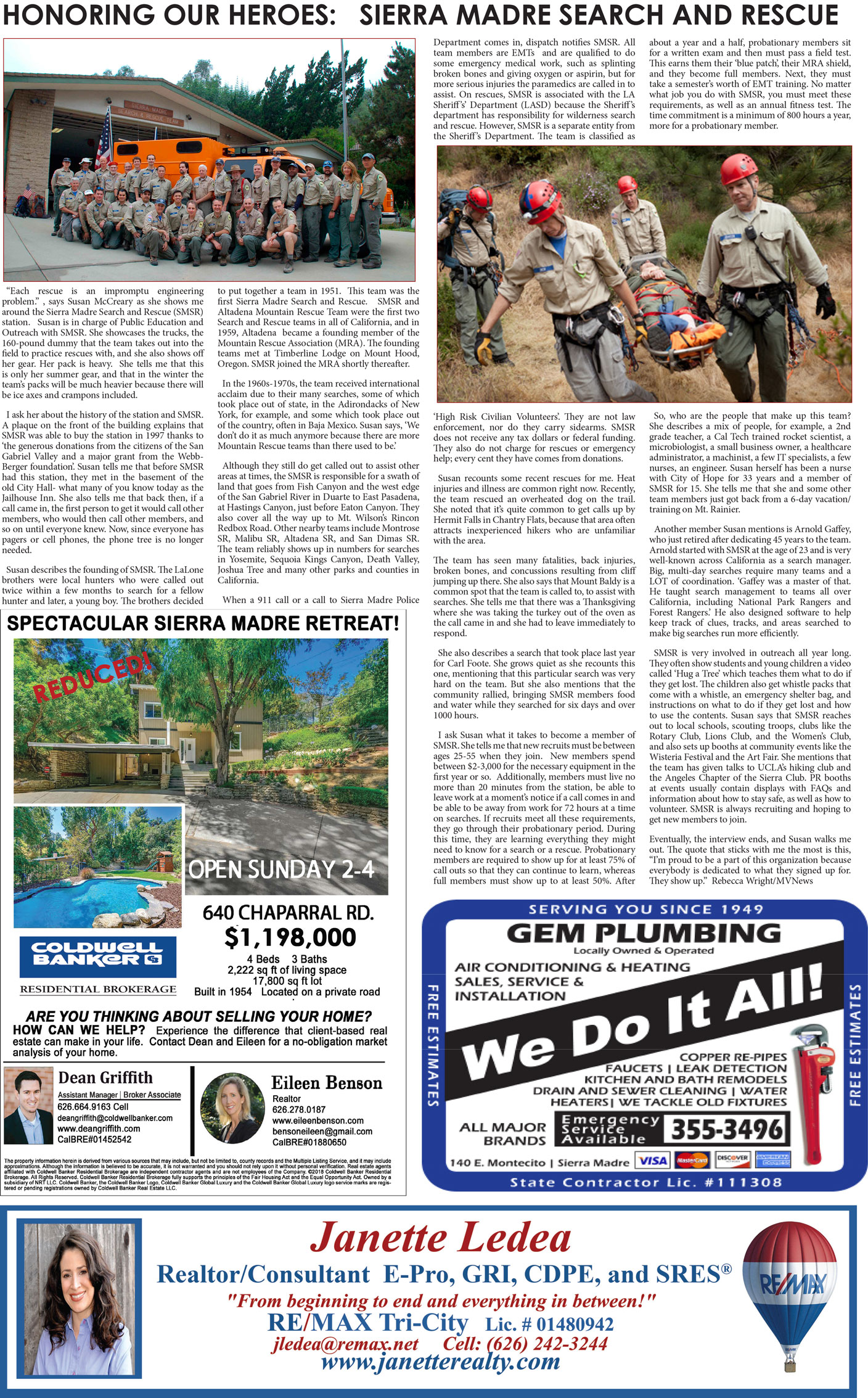|
| ||||||||||||||||||||||
| ||||||||||||||||||||||
Sierra Madre EditionBreaking News:Inside
this Week: Community Calendar: Sierra Madre: Pasadena – Altadena: Arcadia · Monrovia · Duarte: Food, Drink & More: Education / Good Life: Arts and More: Opinion … Left/Right: Columnists: Recent Issues: |
SIERRA MADRE EDITION SATURDAY, AUGUST 11, 2018 VOLUME 12 NO. 32 HONORING OUR HEROES: SIERRA MADRE SEARCH AND RESCUE “Each rescue is an impromptu engineering problem.” , says Susan McCreary as she shows me around the Sierra Madre Search and Rescue (SMSR) station. Susan is in charge of Public Education and Outreach with SMSR. She showcases the trucks, the 160-pound dummy that the team takes out into the field to practice rescues with, and she also shows off her gear. Her pack is heavy. She tells me that this is only her summer gear, and that in the winter the team’s packs will be much heavier because there will be ice axes and crampons included. I ask her about the history of the station and SMSR. A plaque on the front of the building explains that SMSR was able to buy the station in 1997 thanks to ‘the generous donations from the citizens of the San Gabriel Valley and a major grant from the Webb- Berger foundation’. Susan tells me that before SMSR had this station, they met in the basement of the old City Hall- what many of you know today as the Jailhouse Inn. She also tells me that back then, if a call came in, the first person to get it would call other members, who would then call other members, and so on until everyone knew. Now, since everyone has pagers or cell phones, the phone tree is no longer needed. Susan describes the founding of SMSR. The LaLone brothers were local hunters who were called out twice within a few months to search for a fellow hunter and later, a young boy. The brothers decided to put together a team in 1951. This team was the first Sierra Madre Search and Rescue. SMSR and Altadena Mountain Rescue Team were the first two Search and Rescue teams in all of California, and in 1959, Altadena became a founding member of the Mountain Rescue Association (MRA). The founding teams met at Timberline Lodge on Mount Hood, Oregon. SMSR joined the MRA shortly thereafter. In the 1960s-1970s, the team received international acclaim due to their many searches, some of which took place out of state, in the Adirondacks of New York, for example, and some which took place out of the country, often in Baja Mexico. Susan says, ‘We don’t do it as much anymore because there are more Mountain Rescue teams than there used to be.’ Although they still do get called out to assist other areas at times, the SMSR is responsible for a swath of land that goes from Fish Canyon and the west edge of the San Gabriel River in Duarte to East Pasadena, at Hastings Canyon, just before Eaton Canyon. They also cover all the way up to Mt. Wilson’s Rincon Redbox Road. Other nearby teams include Montrose SR, Malibu SR, Altadena SR, and San Dimas SR. The team reliably shows up in numbers for searches in Yosemite, Sequoia Kings Canyon, Death Valley, Joshua Tree and many other parks and counties in California. When a 911 call or a call to Sierra Madre Police Department comes in, dispatch notifies SMSR. All team members are EMTs and are qualified to do some emergency medical work, such as splinting broken bones and giving oxygen or aspirin, but for more serious injuries the paramedics are called in to assist. On rescues, SMSR is associated with the LA Sheriff’s’ Department (LASD) because the Sheriff’s department has responsibility for wilderness search and rescue. However, SMSR is a separate entity from the Sheriff’s Department. The team is classified as ‘High Risk Civilian Volunteers’. They are not law enforcement, nor do they carry sidearms. SMSR does not receive any tax dollars or federal funding. They also do not charge for rescues or emergency help; every cent they have comes from donations. Susan recounts some recent rescues for me. Heat injuries and illness are common right now. Recently, the team rescued an overheated dog on the trail. She noted that it’s quite common to get calls up by Hermit Falls in Chantry Flats, because that area often attracts inexperienced hikers who are unfamiliar with the area. The team has seen many fatalities, back injuries, broken bones, and concussions resulting from cliff jumping up there. She also says that Mount Baldy is a common spot that the team is called to, to assist with searches. She tells me that there was a Thanksgiving where she was taking the turkey out of the oven as the call came in and she had to leave immediately to respond. She also describes a search that took place last year for Carl Foote. She grows quiet as she recounts this one, mentioning that this particular search was very hard on the team. But she also mentions that the community rallied, bringing SMSR members food and water while they searched for six days and over 1000 hours. I ask Susan what it takes to become a member of SMSR. She tells me that new recruits must be between ages 25-55 when they join. New members spend between $2-3,000 for the necessary equipment in the first year or so. Additionally, members must live no more than 20 minutes from the station, be able to leave work at a moment’s notice if a call comes in and be able to be away from work for 72 hours at a time on searches. If recruits meet all these requirements, they go through their probationary period. During this time, they are learning everything they might need to know for a search or a rescue. Probationary members are required to show up for at least 75% of call outs so that they can continue to learn, whereas full members must show up to at least 50%. After about a year and a half, probationary members sit for a written exam and then must pass a field test. This earns them their ‘blue patch’, their MRA shield, and they become full members. Next, they must take a semester’s worth of EMT training. No matter what job you do with SMSR, you must meet these requirements, as well as an annual fitness test. The time commitment is a minimum of 800 hours a year, more for a probationary member. So, who are the people that make up this team? She describes a mix of people, for example, a 2nd grade teacher, a Cal Tech trained rocket scientist, a microbiologist, a small business owner, a healthcare administrator, a machinist, a few IT specialists, a few nurses, an engineer. Susan herself has been a nurse with City of Hope for 33 years and a member of SMSR for 15. She tells me that she and some other team members just got back from a 6-day vacation/ training on Mt. Rainier. Another member Susan mentions is Arnold Gaffey, who just retired after dedicating 45 years to the team. Arnold started with SMSR at the age of 23 and is very well-known across California as a search manager. Big, multi-day searches require many teams and a LOT of coordination. ‘Gaffey was a master of that. He taught search management to teams all over California, including National Park Rangers and Forest Rangers.’ He also designed software to help keep track of clues, tracks, and areas searched to make big searches run more efficiently. SMSR is very involved in outreach all year long. They often show students and young children a video called ‘Hug a Tree’ which teaches them what to do if they get lost. The children also get whistle packs that come with a whistle, an emergency shelter bag, and instructions on what to do if they get lost and how to use the contents. Susan says that SMSR reaches out to local schools, scouting troops, clubs like the Rotary Club, Lions Club, and the Women’s Club, and also sets up booths at community events like the Wisteria Festival and the Art Fair. She mentions that the team has given talks to UCLA’s hiking club and the Angeles Chapter of the Sierra Club. PR booths at events usually contain displays with FAQs and information about how to stay safe, as well as how to volunteer. SMSR is always recruiting and hoping to get new members to join. Eventually, the interview ends, and Susan walks me out. The quote that sticks with me the most is this, “I’m proud to be a part of this organization because everybody is dedicated to what they signed up for. They show up.” Rebecca Wright/MVNews Mountain Views News 80 W Sierra Madre Blvd. No. 327 Sierra Madre, Ca. 91024 Office: 626.355.2737 Fax: 626.609.3285 Email: editor@mtnviewsnews.com Website: www.mtnviewsnews.com | |||||||||||||||||||||
| ||||||||||||||||||||||
| Mountain Views News 80 W. Sierra Madre Blvd. #327 Sierra Madre, Ca. 91024 Office: 626.355.2737 Fax: 626.604.4548 www.mtnviewsnews.com | ||||||||||||||||||||||




















